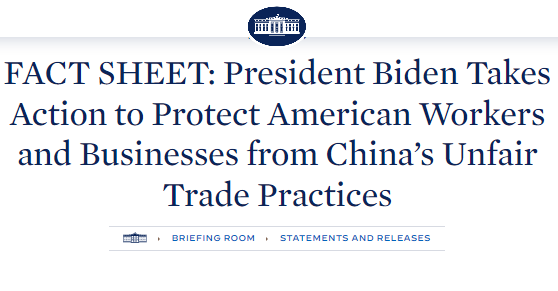PVTIME – On 14 May 2024, the White House announced that US President Biden was directing his Trade Representative to increase tariffs on $18 billion of imports from China under Section 301 of the Trade Act of 1974 in order to protect American workers and businesses.

The tariff increases cover strategic sectors including steel and aluminium, semiconductors, electric vehicles, batteries, critical minerals, solar cells, ship-to-shore cranes and medical products.
The Section 301 tariff rate on certain steel and aluminium products will increase from 0-7.5% to 25% in 2024.
The tariff rate on semiconductors will increase from 25% to 50% in 2025.
The Section 301 tariff rate on electric vehicles will increase from 25% to 100% in 2024.
The tariff rate on lithium-ion EV batteries will increase from 7.5% to 25% in 2024, while the tariff rate on lithium-ion non-EV batteries will increase from 7.5% to 25% in 2026. The tariff rate on battery parts will increase from 7.5% to 25% in 2024.
For natural graphite and permanent magnets, the tariff rate will increase from zero to 25% in 2026. For certain other critical minerals, the rate will increase from zero to 25% in 2024.
Particularly, the tariff rate on solar cells (whether or not assembled into modules) will increase from 25% to 50% in 2024.
The US said the tariff increase will protect against China’s policy-driven overcapacity that depresses prices and inhibits the development of solar capacity outside of China. China has used unfair practices to dominate more than 80-90% of certain parts of the global solar supply chain and is seeking to maintain that status quo. Chinese policies and non-market practices flood global markets with artificially cheap solar modules and panels, undermining investment in solar manufacturing outside of China. The Biden-Harris Administration has made historic investments in the US solar supply chain, building on early US government-sponsored research and development that helped create solar cell technologies. The Act provides supply-side tax incentives for solar components, including polysilicon, wafers, cells, modules and backsheet materials, as well as tax credits and grant and loan programmes to support the deployment of utility-scale and residential solar energy projects. As a result of President Biden’s Investing in America agenda, solar manufacturers have already announced nearly $17 billion in planned investments under his administration – an eightfold increase in U.S. manufacturing capacity, enough to supply panels for millions of homes annually by 2030.

Scan the QR code to follow PVTIME official account on Wechat for latest news on PV+ES











